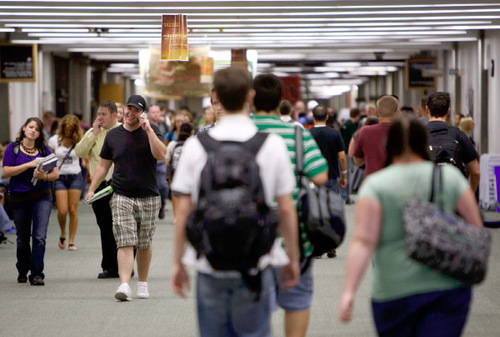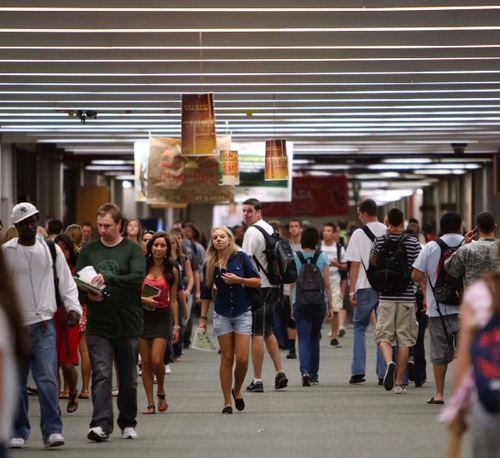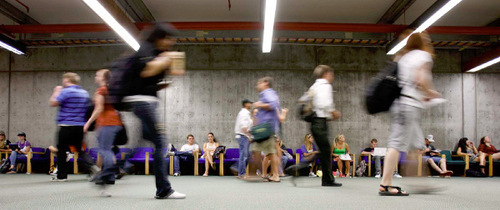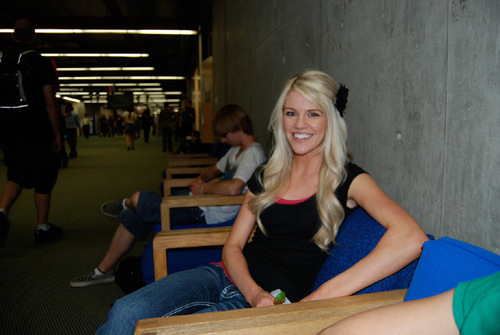This is an archived article that was published on sltrib.com in 2010, and information in the article may be outdated. It is provided only for personal research purposes and may not be reprinted.
Orem • The hallways in Utah Valley University's Liberal Arts Building are so wide that students use them as study lounges as much as corridors. But as the fall semester began Wednesday, the concourses were so crowded with students rushing to class, working their cell phones and laptops, that walking across them was difficult.
For the third fall in a row, UVU and the state's other open-admission institutions are experiencing all-time high enrollments, forcing administrators to take "creative" steps to maximize use of space. Meanwhile, many UVU students are consigned to wait lists for required courses and face inconvenient schedules even if spaces come available.
"I got into some of my classes easily, others not so easily," said Scott Sundblom, while taking care of business in the administration building Wednesday. "I'm wait-listed in multiple scenarios."
He is waiting to get into three required courses — physical science, economics and English.
"I'm trying to finish my general education. I'm doing my best to get rid of all those courses because it makes it easier to get classes in the [Woodbury] School of Business," said Sundblom, who is married with a small child and would be working this semester were he not recovering from knee surgery.
Official enrollment figures aren't recorded until the third week each semester, but course registrations this week give a clear indication of where the numbers are headed, officials say. UVU could wind up with as many as 3,000 more students this year than last fall. SLCC is expecting almost 900 more students, and Weber about 1,000. Dixie State College will likely see substantial growth and even the private Westminster College will set an enrollment record this fall for the sixth straight year. The small liberal arts school in Salt Lake City welcomes its largest-ever freshman class of 530.
The college enrollment boom is a national phenomenon, driven by the worst job market in decades.
At Utah's big open-admission schools, bottlenecks are clogging access to core curriculum classes that everyone must pass for graduation, so officials are opening new English course sections and expanding computer labs. Weber State University, for example, added 130 computer stations to teach the record 3,500 students signed up for Math 1010 this semester, according to Provost Michael Vaughan.
But at UVU, there is simply no more space, so administrators are considering replacing low-enrollment elective courses with high-demand required ones. But there appear to be few low-demand classes to cancel, according Michelle Taylor, UVU's director of enrollment management.
Students are "definitely frustrated, but they understand there are a lot of people who want to come here," said student president Richard Portwood. "Every year we are awarding more bachelor's degrees, so people are sticking around longer."
Enrollment growth is bittersweet for UVU administrators and students. On one hand, it reflects broad confidence in the school, only two years into its status as a university. But if students cannot get needed classes, their progress toward graduation will stall.
During these last few years of enrollment surges, UVU's six-year graduation rates have slipped from 26 to 23 percent, according to the National Center for Education Statistics. This poor showing earned UVU a spot on Washington Monthly's new list of the nation's 50 worst "dropout factories," the schools with the lowest graduation rates.
Whether UVU deserves such a label is debatable, but sagging graduation rates are something officials are working to reverse with programs to promote student engagement with campus life and better advising.
Although the rate of enrollment growth appears to be slowing this fall, Utah's campuses still must accommodate ever-growing numbers despite shrinking state support and no additional space.
In the case of Salt Lake Community College (SLCC), crowding has been exacerbated by the college's departure from its rented Sandy campus in a cost-cutting move, lowering capacity by 2,700. These students must be attend classes at SLCC's 13 remaining sites.
To help absorb the influx, the college will launch a mini-term on Oct. 19, opening 50 course sections to serve 1,377 students whose entire semester will be compressed into eight weeks.
"They are getting the same experience, just accelerated," said college spokesman Joy Tlou. "We are running more efficiently than we ever have. We are looking at every sliver to make sure every seat is filled."
Of the state's eight public institutions, SLCC and UVU are given the least amount of state money and have the least amount of space per student. Both schools have major classroom-building projects under construction, but they will not be online until 2012. UVU is hoping to purchase 100 acres of nearby Geneva Steel land to develop into a future satellite.
Until relief arrives in the form of increased funding and new buildings, the university is scheduling every classroom for 12 or more hours six days a week. Officials have started an e-mail system to automatically alert wait-listed students of openings in the courses they want to ensure open seats are filled.
"The wait list goes for one week and then they have a week where they can use an add card where the professor can allow them in if they have enough seats," Taylor said.
The best advice is to register as early as possible and learn how the system works, said students who got into the classes they wanted.
Crowd control
While official enrollment numbers won't be available until September, Utah Valley University is anticipating record-high enrollment this year. How crowded is it? Officials are scheduling every classroom at least 12 hours a day, six days a week.











